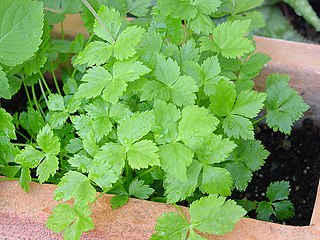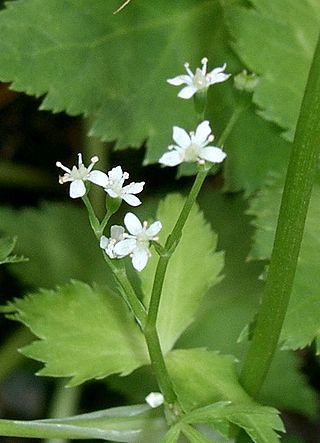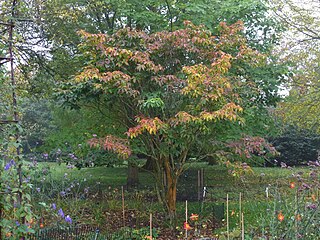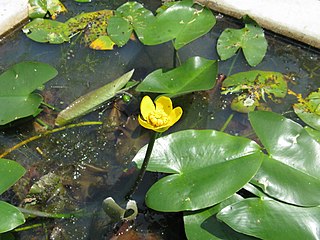
Cryptomeria is a monotypic genus of conifer in the cypress family Cupressaceae, formerly belonging to the family Taxodiaceae. It includes only one species, Cryptomeria japonica. It used to be considered by some to be endemic to Japan, where it is known as Sugi. The tree is called Japanese cedar or Japanese redwood in English. It has been extensively introduced and cultivated for wood production on the Azores.

Lonicera japonica, known as Japanese honeysuckle and golden-and-silver honeysuckle, is a species of honeysuckle native to eastern Asia, including many parts of China. It is often grown as an ornamental plant, but has become an invasive species in a number of countries. Japanese honeysuckle is used in traditional Chinese medicine.

Cryptotaenia, or honewort, is a genus of herbaceous perennial plants, native to North America, Africa, and eastern Asia, growing wild in moist, shady places.

Cryptotaenia japonica, also called East Asian wildparsley, Japanese cryptotaenia, Japanese honewort, white chervilmitsuba, Japanese wild parsley, stone parsley, honeywort, san ip, trefoil, and san ye qin is a plant species native to Japan, Korea, and China. The plant is edible and is commonly used as a garnish and root vegetable in Japan, and other Asian countries.

Neoshirakia, known as milktree, is a genus of plants in the Euphorbiaceae, native to east Asia. It is part of a group first described in 1954 with the name Shirakia, but this proved to be an illegitimate name, unacceptable under the Code of Nomenclature. The genus was later divided, with its species distributed amongst three genera: Neoshirakia, Shirakiopsis, and Triadica. Neoshirakia contains only one known species, Neoshirakia japonica, known as tallow tree, native to China, Korea, and Japan. The name Shirakia thus became a synonym of Neoshirakia because S. japonica was the type species for that genus, the species now renamed N. japonica.

Atractylodes is a genus of Asian flowering plants in the family Asteraceae.

Ardisia japonica, known as marlberry, is a species of Ardisia native to eastern Asia, in eastern China, Japan and Korea.

Osmunda japonica, also called Asian royal fern or fiddlehead, is a fern in the genus Osmunda native to east Asia, including Japan, China, Korea, Taiwan, and the far east of Russia on the island of Sakhalin. It is called gobi in Korean, zenmai in Japanese, and zǐqí or juécài in Chinese.

Eurya japonica, known as East Asian eurya, is a 1–3.5 m tall shrub in the Pentaphylacaceae family found in eastern China, Korea, and Japan. It is used as an ornamental plant. In shinto it is a sacred tree, whose leaves are used as sacrificial offerings.

The genus Platanthera belongs to the subfamily Orchidoideae of the family Orchidaceae, and comprises about 150 species of orchids. The members of this genus, known as the butterfly orchids or fringed orchids, were previously included in the genus Orchis, which is a close relative. They are distributed throughout the temperate regions of the Northern Hemisphere. They are terrestrial and have tubercules.
Ostrya japonica, known as East Asian hophornbeam, or Japanese hop-hornbeam, is a species of tree in the Betulaceae family growing to 25 m tall. It is native to Japan, Korea and China. In China, it occurs in temperate forests of southern Gansu, Hebei, Henan, Hubei, and Shaanxi provinces at altitudes between 1,000–2,800 metres (3,300–9,200 ft). In Japan it is known as Asada (浅田).

Aucuba japonica, commonly called spotted laurel, Japanese laurel, Japanese aucuba or gold dust plant (U.S.), is a shrub native to rich forest soils of moist valleys, thickets, by streams and near shaded moist rocks in China, Korea, and Japan. This is the species of Aucuba commonly seen in gardens - often in variegated form. The leaves are opposite, broad lanceolate, 5–8 cm (2.0–3.1 in) long and 2–5 cm (0.79–1.97 in) wide. Aucuba japonica are dioecious. The flowers are small, 4–8 mm (0.16–0.31 in) diameter, each with four purplish-brown petals; they are produced in clusters of 10-30 in a loose cyme. The fruit is a red drupe approximately 1 cm (0.39 in) in diameter that is avoided by birds.

Pollia japonica, known as East Asian pollia in English, yabumyoga (ヤブミョウガ) in Japanese, and dùruò (杜若) in Chinese, is a perennial flower native to East Asia. Its niche is forests 0–1200 m. It is native in Anhui, Fujian, Guangdong, Guangxi, Guizhou, Hubei, Hunan, Jiangxi, and Sichuan Provinces of China. It is also found in Taiwan, Japan, and Korea.
P. japonica may refer to:

Salvia japonica, known as East Asian sage, is an annual plant that is native to several provinces in China and Taiwan, growing at 200 to 1,200 m elevation. S. japonica grows on erect stems to 40 to 60 cm tall. Inflorescences are 2-6 flowered verticillasters in terminal racemes or panicles, with a corolla that varies in color from reddish, purplish, bluish, to white, and is approximately 1.2 cm (0.47 in).

Dioscorea japonica, known as East Asian mountain yam, yamaimo, or Japanese mountain yam, is a type of yam (Dioscorea) native to Japan, Korea, China, Taiwan, and Assam.

Nuphar japonica, known as East Asian yellow water-lily, is an aquatic plant species in the genus Nuphar found in Japan and the Korean Peninsula. It is endangered in Russia. The species was not accepted by The Plant List as of November 2013, which regarded it as an "unresolved name".

Orixa japonica, commonly called East Asian orixa or Japanese orixa, is a deciduous shrub growing to 3 metres (10 ft) with an equal spread. Native to Japan and South Korea, it is found on forested, sunny slopes at elevations from 500 to 1300 m. A recent scientific study found this plant to contain previously unknown alkaloids that may be effective against Plasmodium falciparum, one of the protozoan species that cause human malaria.

Pogonia is a genus of orchids belonging to the subfamily Vanilloideae.

Alnus japonica, known as Japanese alder, is a species of Alnus from Japan, Korea, Taiwan, eastern China, and Russia.


















